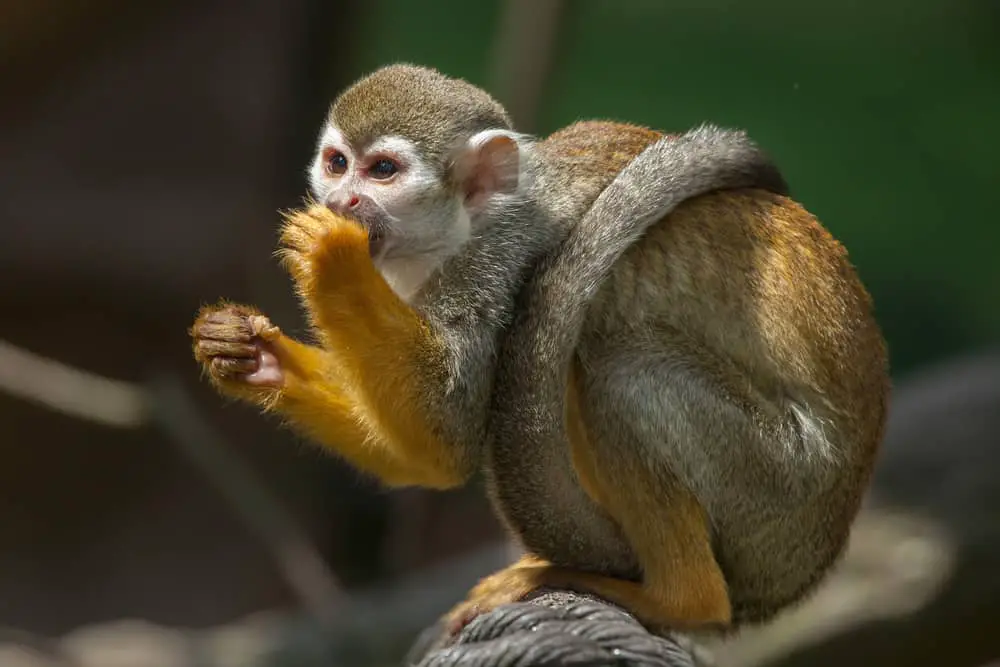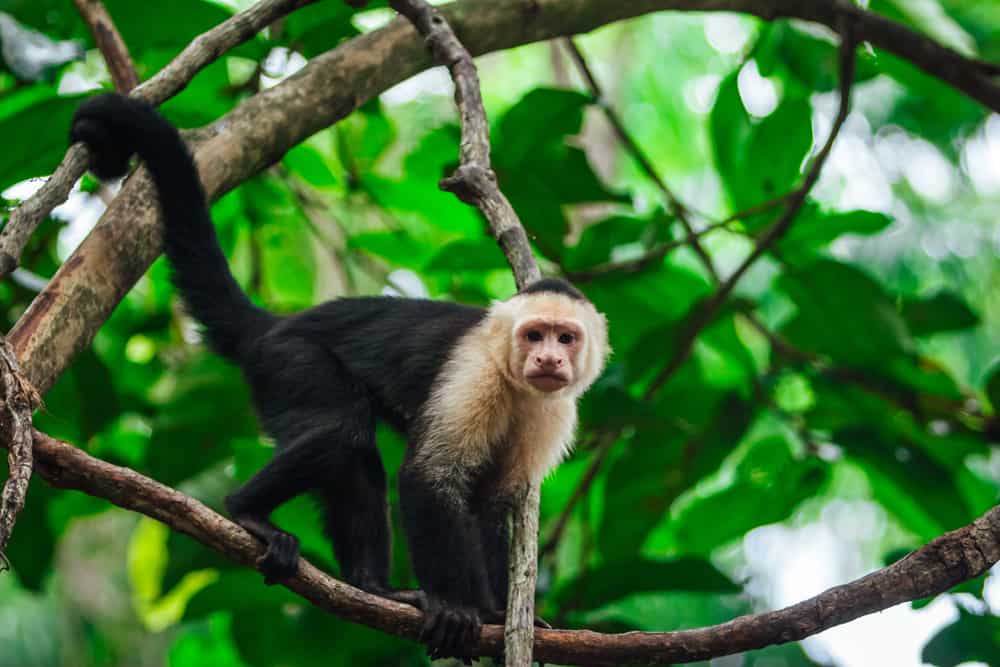Cebidae is a family of New World monkeys that inhabits the tropical forests of Central and South America. This group comprises 14 genera and over 60 species, including some of the most familiar primates such as capuchin monkeys, squirrel monkeys, spider monkeys, and howler monkeys.
The Cebidae family has captured the attention of researchers for decades due to their unique morphology, social behavior, cognitive abilities, ecological role, and conservation status.
Cebids are small to medium-sized arboreal primates with long tails that allow them to balance while moving through the trees. They have forward-facing eyes that provide excellent binocular vision necessary for depth perception in their three-dimensional environment.
Most cebid species are diurnal and live in large groups consisting of males, females, and offspring. These animals display an array of communicative behaviors using vocalizations, facial expressions, body postures, grooming interactions, and scent marking. Furthermore, they exhibit remarkable cognitive skills such as tool use and problem-solving abilities that rival those observed in great apes.
Despite their fascinating characteristics and diverse adaptations to forest life, many cebid populations face multiple threats from habitat loss, hunting pressure, pet trade exploitation, disease outbreaks among others.

Subfamilies and Genera
- Subfamily Cebinae
- Genus Cebus – gracile capuchin monkeys
- Genus Sapajus – robust capuchin monkeys
- Subfamily Saimirinae
- Genus Saimiri – squirrel monkeys
Morphology And Adaptations Of Cebidae
The Cebidae family is diverse and includes various species of New World monkeys such as capuchin, squirrel, and howler monkeys. These primates are found in Central and South America and have evolved unique adaptations to their environment over time.
Among the many features that distinguish this group from others is their comparative locomotion. Cebids exhibit a variety of locomotor behaviors, including quadrupedalism (using all four limbs), brachiation (swinging from branch to branch using arms), leaping, and running. They possess prehensile tails that can grasp onto branches with ease, which helps them move around arboreal environments efficiently.
Their dental adaptations include having long incisors for cracking open hard-shelled fruits, broad molars for processing tough fibrous vegetation, and sharp canine teeth for defense against predators. The cebid’s unique morphology allows it to exploit different food sources within its habitat.
Social Behavior And Communication
The morphology and adaptations of Cebidae have been extensively studied, but their social behavior and communication are equally fascinating.
These primates exhibit a wide range of social behaviors that include cooperation, altruism, and competition. Social learning is an integral part of the development of these behaviors since young individuals learn from adults through observation and imitation.
Vocalizations and gestures play a significant role in the communication between members of Cebidae families. They use various vocalizations such as screams, grunts, whistles, and trills to convey different messages like danger alerts or food availability. Moreover, they also communicate through body language by using facial expressions, head movements, postures, and grooming behaviors to establish dominance hierarchies or express affection towards each other.
Understanding their complex social interactions requires close observations and analysis of their communicative signals.
- The four ways in which Cebidae demonstrate social behavior:
- Cooperation
- Altruism
- Competition
- Dominance hierarchy establishment
- The four types of vocalizations used by Cebidae for communication:
- Screams
- Grunts
- Whistles
4.Trills
- Examples of bodily gestures used by Cebidae for communication:
- Facial Expressions.
- Head Movements.
- Postures.
- Grooming Behaviors.
In conclusion, the study of social behavior and communication among Cebidae highlights their intricate relationships with each other within their family groups while providing insight into how they adapt to changes within their environment over time. Through observing their social learning processes as well as studying their vocalizations and gestures used during communication we gain a deeper understanding regarding how these primates survive in the wild despite challenges such as predation pressures or resource scarcity at times throughout life cycles affected by environmental changes.
Cognitive Abilities Of Cebids
Amidst the lush leaves of the forest, cebids swing with nimble ease from branch to branch. These primates are known for their cognitive flexibility and problem-solving abilities that allow them to survive in their natural habitat.
Cognitive flexibility refers to the ability of an individual to switch between different tasks or mental sets depending on what is required at a given moment. Cebids exhibit this trait when they adapt quickly to changes in their environment, such as new food sources or predators.
Furthermore, studies have shown that cebids possess impressive problem-solving abilities. They can use tools to obtain food and even learn from each other’s techniques. In one study, capuchin monkeys were able to solve a puzzle where they had to choose a tool to reach a piece of fruit out of reach. This shows how adaptable and intelligent these primates truly are.
Overall, the cognitive abilities of cebids make them fascinating creatures that continue to captivate researchers and nature enthusiasts alike.
Ecological Role And Conservation Status
Cebidae plays a crucial ecological role in its habitat as they are important seed dispersers for various plant species. Their frugivorous diet allows them to consume fruits and disperse seeds through their feces, which aids in the regeneration of tropical forests.
Additionally, cebids also serve as prey for predators like jaguars, ocelots, and eagles. They contribute to the food web by providing sustenance for these carnivores.
The conservation status of cebidae varies among different species. Some populations are listed as endangered due to habitat loss caused by deforestation, hunting, and pet trade.
To address this issue, conservation efforts have been implemented such as the establishment of protected areas and rehabilitation centers. Habitat restoration programs have also been initiated to restore degraded habitats and promote biodiversity conservation. These initiatives aim to protect cebids’ natural environment and ensure their survival in the wild.
Threats To Cebidae Populations
The lush canopies of tropical forests have always been the kingdom of Cebidae, where they thrive and play a vital role in balancing the local ecosystem.
Sadly, human encroachment has threatened these primates’ habitats, leading to significant population declines.
The expansion of agriculture and urbanization into previously undisturbed areas has resulted in habitat fragmentation, which disrupts the natural distribution patterns and social structures of Cebidae populations.
In addition to habitat destruction, poaching poses another significant threat to Cebidae populations.
Primarily hunted for their meat or captured for pet trade, these activities result in several negative impacts on primate groups.
Poaching often leads to a reduction in genetic diversity within populations, as well as changes in reproductive behavior and reduced survival rates.
While conservation efforts are underway worldwide to protect these endangered species from further harm, it is crucial that we continue advocating for better policies to address both human encroachment and poaching challenges facing Cebidae populations today.

Future Directions For Cebidae Research And Conservation
As we continue to learn more about the biology and behavior of cebids, it is important to direct our efforts towards research that will inform effective conservation strategies. Specifically, future studies should focus on two main areas: conservation genetics and habitat restoration.
Conservation genetics research can help us better understand the genetic diversity within cebid populations, which in turn can inform management decisions aimed at maintaining healthy populations. This type of research may also be useful in identifying potential threats to specific subpopulations or subspecies, allowing managers to take action before a decline occurs. Additionally, as gene editing technologies become increasingly advanced, there may be opportunities for targeted interventions that could benefit cebid populations facing particular challenges.
Habitat restoration is another key area where future research efforts should be directed. As human activities continue to encroach upon natural habitats, many species are struggling to adapt. For cebids specifically, changes in forest structure and composition have been shown to negatively impact their survival and reproductive success.
Restoration initiatives such as reforestation or invasive species removal could therefore play an important role in maintaining viable cebid populations over the long term. Ultimately, by continuing to study these remarkable primates and taking action to protect them from anthropogenic threats, we can ensure that they remain a vital component of tropical ecosystems for generations to come.
Conclusion
Cebidae, a family of New World monkeys, have evolved to thrive in their diverse habitats. Their unique morphological and behavioral adaptations allow them to forage for food and communicate effectively with their social groups. Cebids also possess advanced cognitive abilities that enable them to solve complex problems and navigate their environment.
Despite their ecological importance, cebid populations are threatened by habitat loss and fragmentation, hunting, and the pet trade. Conservation efforts must prioritize protecting these primates and preserving their habitats to ensure their survival.
Looking forward, continued research on cebidae can provide valuable insights into primate behavior and evolution. By understanding how they adapt to changing environments, we can develop strategies to mitigate the impact of human activities on these important species.
In conclusion, what other fascinating discoveries will we make about these intelligent New World monkeys? Only time will tell.
